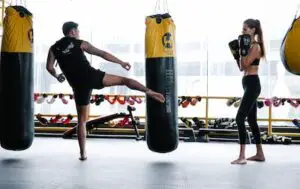Karate is a martial art that has been practiced for centuries, originating in Okinawa, Japan. Karate involves a range of techniques, including strikes, throws, and joint locks, but one of the most important aspects of karate training is sparring.
Sparring in karate refers to the practice of fighting with an opponent in a controlled environment. It is an essential part of karate training, as it allows students to apply the techniques they have learned in a realistic setting and develop their fighting skills.
In this article, we will explore sparring in karate in-depth, covering topics such as its purpose, rules, different types of sparring, and how to prepare for it.
What is the purpose of sparring in karate?
The purpose of sparring in karate is to develop a student’s fighting abilities and improve their martial arts skills. Sparring allows students to put their techniques into practice against a live opponent, giving them a better understanding of how to use them effectively.
Sparring also helps students develop self-control, discipline, and mental toughness. It teaches them how to remain calm and focused under pressure, which can be applied to many other aspects of life.
What are the rules of sparring in karate?
Sparring in karate is often governed by a set of rules designed to ensure the safety of the participants. Some common rules include:
– Wearing protective gear, such as gloves, headgear, and mouthguards
– No strikes allowed to the groin, throat, or spine
– No techniques allowed to the face in light contact sparring
– No hitting after the referee has called a stop to the action
– No unsportsmanlike behavior, such as intentional strikes after the referee has called a stop to the action or excessive contact
These rules may vary depending on the style of karate or the tournament organizers.
What are the different types of sparring in karate?
There are several different types of sparring in karate, each with its own rules and objectives. Some of the most common types include:
– Kata-based sparring: This type of sparring involves two opponents performing a prearranged sequence of techniques, similar to a kata. The goal is to perform the techniques with precision, speed, and power.
– Light contact sparring: This type of sparring is often used for beginners or younger students. The goal is to make light contact with your opponent, demonstrating control and technique rather than power.
– Point sparring: In point sparring, the goal is to land strikes on your opponent and earn points. The first person to reach a predetermined number of points wins the match.
– Continuous sparring: This type of sparring involves non-stop fighting for a set period of time. The goal is to score as many points as possible, either through strikes or takedowns.
– Full-contact sparring: This type of sparring is the most intense, with fighters using full power and no protective gear. It is often reserved for advanced students and professional fighters.
What are some tips for sparring in karate?
Sparring can be intimidating, especially for beginners. Here are some tips to help you prepare and perform well during a sparring match:
– Train consistently: Sparring is a physical activity, and it takes time and effort to develop the necessary skills. Make sure you train regularly and with purpose, focusing on technique, speed, and power.
– Learn from your mistakes: Don’t get discouraged if you make mistakes during sparring matches. Use each match as a learning opportunity, and work on improving your weak points.
– Watch and learn: Observe other sparring matches, either in person or online, to pick up tips and techniques that you can incorporate into your own practice.
– Stay focused: Sparring requires mental toughness as well. Stay focused, calm, and aware of your opponent’s movements.
– Stay safe: Always follow the rules and use protective gear when required. Don’t use excessive force or unsportsmanlike behavior, and stop if you or your opponent are injured.
– Communicate with your opponent and coach: Before, during, and after the sparring match, communicate with your opponent and coach. Ask for feedback, strategy, and tips to improve your performance.
How do you prepare for sparring in karate?
Preparing for sparring in karate involves a combination of physical and mental training. Here are some of the best ways to prepare for sparring:
– Train regularly: As mentioned earlier, regular training is essential to develop the necessary skills for sparring.
– Cardiovascular training: Sparring can be exhausting, so make sure you are in good cardiovascular shape. This can include running, biking, or other cardio exercises.
– Strength training: Strength training is also important for sparring. Focus on building strength in your core, legs, and arms.
– Stretching: Flexibility is essential for many of the techniques used in sparring. Make sure you stretch before and after training to avoid injury.
– Visualize: Mental preparation is just as important as physical preparation. Visualize yourself performing well during sparring matches, focusing on precision, speed, and power.
Conclusion
Sparring in karate is an essential part of the training process. It allows students to develop their fighting skills, mental toughness, and self-control in a safe and controlled environment. By understanding the purpose of sparring, its rules, types, and tips for preparation, students can effectively prepare for sparring matches and improve their overall martial arts skills.





